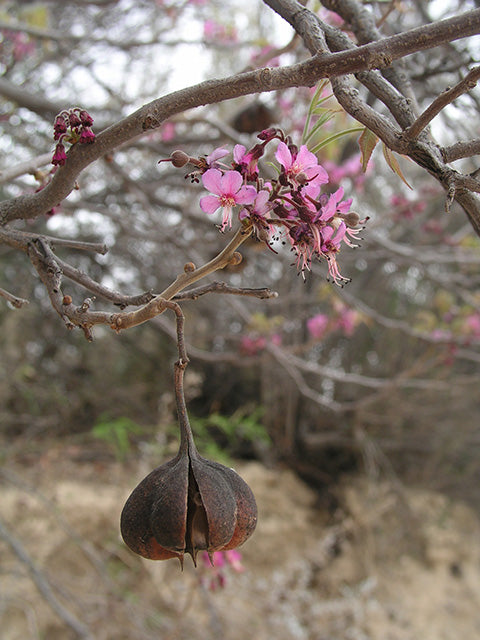Mexican Buckeye (Ungnadia speciosa)
Mexican Buckeye (Ungnadia speciosa)
Low stock: 6 left
Couldn't load pickup availability
Ungnadia speciosa Endl.
Mexican Buckeye, Monilla
Sapindaceae (Soapberry Family)
Synonym(s):
USDA Symbol: unsp
Mexican-buckeye, an 8-12 ft., deciduous tree, can reach 30 ft. in height. It is often multi-trunked with with light gray to brown bark, smooth on young branches, becoming fissured with age. Leaves up to 12 inches long, with a central axis supporting 2 to 6 paired leaflets and a terminal one; leaflets up to 5 inches long, ovate to narrower with an elongate tip, rounded base, and serrate margins. Pinnate foliage turns golden yellow in fall. Clusters of bright-pink, fragrant flowers appear before or with the leaves from the axils of the previous season. Fruit distinctive, a light reddish brown when ripe, 3 lobed capsule containing 1 to 3 dark brown to black, shiny seeds 1/2 inch in diameter, the walls of the capsule often persisting through the winter, seeds poisonous.
From a distance the plants in full flower resemble redbuds or peaches. The sweetish but poisonous seeds are sometimes used by children as marbles. Livestock seldom browse the toxic foliage, but bees produce fragrant honey from the flowers. Although not a true buckeye, it is so called because of the similar large capsules and seeds. This distinct plant, alone in its genus, commemorates Baron Ferdinand von Ungnad, Austrian ambassador at Constantinople, who introduced the Horsechestnut into western Europe in 1576.
Plant Characteristics
Duration: Perennial
Habit: Tree
Leaf Retention: Deciduous
Leaf Arrangement: Alternate
Leaf Complexity: Pinnate
Leaf Shape: Ovate
Leaf Margin: Serrate
Fruit Type: Capsule
Size Notes: Up to about 30 feet tall.
Bloom Information
Bloom Color: Pink
Bloom Time: Mar , Apr , May , Jun
Distribution
USA: NM , TX
Native Distribution: TX & s. NM to n.e. Mex.
Native Habitat: Rocky canyons & ridges. Common in rocky areas in canyons and on slopes and ridges in South, Central, and West Texas, east to Dallas county.
Growing Conditions
Water Use: Low
Light Requirement: Sun , Part Shade
Soil Moisture: Dry
Cold Tolerant: yes
Soil Description: Rocky soils. Rocky, Sandy, Sandy Loam, Medium Loam, Clay Loam, Clay, Caliche type Limestone-based
Conditions Comments: Mexican buckeye produces an opulent show when it blooms. The foliage turns a clear yellow in the fall. Foliage, flowers and dense branching makes this species an outstanding small specimen tree or tall background shrub. Rapid-growing, drought-resistant, resistant to cotton root rot. Prune to encourage a single trunk if desired. Growth characteristics of this tree vary greatly with site. It has mildly poisonous seedpods.
Benefit
Use Ornamental: Showy, Aromatic, Accent shrub, Fall conspicuous, Understory tree, Attractive, Blooms ornamental
Use Wildlife: Nectar-bees, Nectar-butterflies, Nectar-moths, Seeds-granivorous birds, Seeds-Small mammals.
Conspicuous Flowers: yes
Fragrant Flowers: yes
Interesting Foliage: yes
Attracts: Butterflies
Larval Host: Henry's Elfin butterfly
Nectar Source: yes
Deer Resistant: High
Image Information
Photographer: Alex, BettyCounty: Brewster
State: TX
Location Notes: Sawmill Road.
Accession date: 2025-05-27
Filename: BIBE_IMG10360.JPG
Slide Index: P3194206.JPG
Restrictions: Unrestricted
Collection: Big Bend Flora
Original Format: Digital
Orientation: Portrait
Shot: Close-up of a flowering/fruiting branch.
Date Taken: 2006-03-19
NPIN Image Id: 172970


